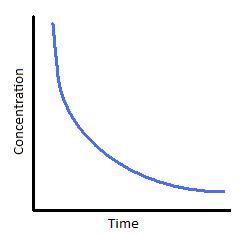The First-order Rate Law calculator computes the reaction rate of concentration change of a substance based on a Rate Law equation, the initial concentration (A0) and the rate constant (k) .
INSTRUCTIONS: Choose the preferred units and enter the following:
- [A0] Initial Concentration of Substance
- (k) The rate constant
Reaction Rate: The calculator returns the rate of reaction of the substance moles per liter per second (mol/(L*s) ).
Chemistry Rate Law Calculators
- Zero Order Rate Law (Integral form)
- Zero Order Half Life
- Zero Order Rate Law
- First Order Rate Law (Integral form)
- First Order Half Life
- First Order Rate Law
- Second Order Rate Law (Integral form)
- Second Order Half Life
- Second Order Rate Law
The Science
 The first-order rate law equation[1] calculates the rate at which the products get converted to reactants, such that the rate depends on a concentration of only one reactant. The equation shown above is the differential[3] form of the first-order rate equation, which describes the rate on a molecular level and shows how the rate depends on the concentration of the reactants. Recall that rate in a differential form is d/dt and can be integrated. You can find a full integration of the first-order rate law here.
The first-order rate law equation[1] calculates the rate at which the products get converted to reactants, such that the rate depends on a concentration of only one reactant. The equation shown above is the differential[3] form of the first-order rate equation, which describes the rate on a molecular level and shows how the rate depends on the concentration of the reactants. Recall that rate in a differential form is d/dt and can be integrated. You can find a full integration of the first-order rate law here.
The Math
The equation is
Rate=k[A]1=k[A] [2]
where
- Rate is the rate of the first order reaction in units of (Molarity/time)
- k is the rate constant of the reaction in units (1/time)
- [A] is the concentration of the reactants in units of (mol/L)
Related Topics
Supplement Material
- Khan Academy: Rate law and reaction order
- Rate and Order of Reactions
References
[1]https://en.wikipedia.org/wiki/Rate_equation
[2]Whitten, et al. 10th Edition. Pp. 626,629,631
[3]https://en.wikipedia.org/wiki/Differential_equation
[Picture] http://chemwiki.ucdavis.edu/Core/Physical_Chemistry/Kinetics/Reaction_Rates/First-Order_Reactions
